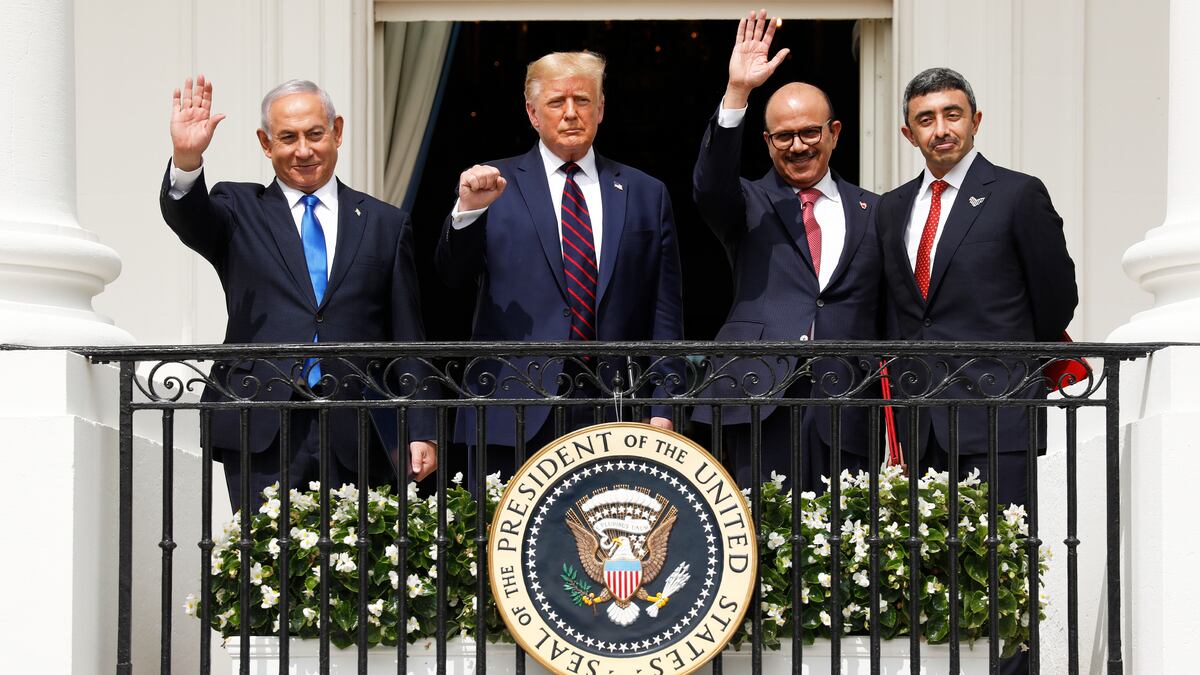JERUSALEM—In the lead-up to the signing of the Abraham Accords in Washington last week, President Donald Trump said that he would be open to sales of the advanced F-35 warplane to the “very wealthy countries” of the Gulf. The F-35, which costs around $80 million a plane, is one of the most expensive U.S. arms programs in history. The Trump administration, which has viewed many of its foreign policy accomplishments as a form of transaction, is supportive of pushing more U.S. arms sales in the wake of the U.S.-Bahrain-UAE deal. It is part of a much larger arms binge now taking place in the Middle East.
The new regional arms race is underpinned by increasing competition between Washington, Moscow, and Beijing and the expansion of the arsenals of strong regional states, such as Israel, Turkey, Iran, and Saudi Arabia. While the U.S. is pushing the F-35 and other hi-tech machines to the Gulf states and Israel, Russia is selling the S-400 air defense system to Turkey and China is pitching armed drones across the Middle East. The big buyers today are mostly on the borders of the Middle East, in contrast to previous arms binges in the region, such as during the Cold War, when the major arms importers were countries like Iraq, Syria and Egypt.
Last year, of the top 15 arms importers in the world, according to the Stockholm International Peace Research Institute (SIPRI), almost half were in the Middle East and North Africa: Saudi Arabia, Algeria, the UAE, Iraq, Qatar, Israel, and Turkey. Turkey, Israel and the UAE are also among the top 20 exporters in the world. The amount of weapons pouring into the region is far beyond the area’s share of the world’s GDP or population, meaning that per capita spending on weapons is the highest in the Middle East. While the world’s spending on arms as a percent of GDP has declined in the last decades, in the Middle East it has increased with countries like Saudi Arabia, Libya, Oman, the UAE, Lebanon, Jordan, Israel, Syria and Bahrain all plowing more than 3.5 percent of GDP into weapons. It’s difficult to quantify if this is the most spending ever in the Middle East on arms because the Cold War arms race in which countries acquired huge arsenals of tanks and planes from the 1960s to 1980s was likely larger in terms of equipment, but the last five years have been unprecedented since the end of the Cold War.
The Trump administration has made arms sales a foundation of its Middle East policy. It fostered its close relationship with Riyadh in 2017 by securing letters of intent for some $110 billion in sales and pushed through $8 billion of the sales in 2019. The White House defied Congress to get the deal done. Reports indicated that the 22 deals for Saudi Arabia and the UAE included Raytheon missiles, Boeing F-15s, Javelin anti-tank missiles, General Electric engines for F-16s. While the U.S got the lion’s share, European companies such as the U.K.’s BAE systems and France’s Thales benefit as well. This included some $20 billion in additional sales in recent years, including for Typhoon and Tornado jets. In July, the U.K. lifted a one-year ban on sales to Riyadh.
The White House has also pushed for opening up sales of U.S. drones to the Middle East. For many years the use of armed drones was reserved for a small fraternity of Western countries and the U.S. was the leader in drone strikes. Proliferation of these systems was seen as a dangerous threat. Abu Dhabi and Riyadh turned to China when they couldn’t acquire armed Predator and Reaper drones, the ones made famous by U.S. targeted strikes in places like Pakistan and Somalia. China’s armed drones have flooded the Middle East in the last decade. Jordan, a Western ally, bought Beijing’s weapons, as did Egypt and other countries. Numerous drones, including some supplied by Turkey, have turned up in Libya’s civil war, violating arms embargoes. In June and July the Trump administration moved to open up sales of U.S. armed drones abroad, particularly to the Gulf.
Drones are not particularly expensive for just a handful, but if you buy enough it adds up. The U.S. Air Force announced a $7.4 billion order of MQ-9 Reapers in September. This will enable the purchase of up to 36 of the drones per year and includes potential foreign military sales.
Increased competition between Washington and Beijing is only part of the story of arms sales to the Middle East. Russia’s sale of its S-400 air defense system to Turkey in 2017 is due to a growing alliance between Ankara and Moscow. For a NATO member like Turkey, this new flirtation with Russia comes as part of a shared worldview between the authoritarian leaders of both countries and increased work on partitioning Syria into spheres of influence.
Moscow has also shopped around its Pantsir and S-300 air defense systems. In a region with more drone threats and rising tensions between Israel and Iran, these systems are in demand. For instance Russia’s Pantsir’s played a role in clashes in Idlib in Syria and in Libya this year. This isn’t always successful for Russia. S-300s in Syria and Pantsir’s in Libya have failed to intercept many airstrikes. Nevertheless, with an arms embargo expiring on Iran it is likely Tehran will be seeking out more Russian munitions, as it has in the past.
The arms purchases by countries in the region feed a growing local arms industry in Iran, Turkey and Israel. In early September, Iran said it looked forward to being an arms exporter soon and it already traffics arms clandestinely to Yemen, Iraq, Syria and Hezbollah in Lebanon. Turkey’s local drone industry has become rapidly successful in making armed drones and large surveillance drones. Israel, partnering with the U.S. on key technologies such as air defense, is a major exporter of weapons systems around the world. Turkey, Greece and Egypt are now all jockeying for influence in the Eastern Mediterranean, fueling expansion of their navies.
The result of the arms binge in the Middle East is a rapid expansion of new technologies and threats, such as Iranian ballistic missiles and new drones being used in conflicts from Yemen to Libya. The era where the Middle East was known for the global war on terror and insurgencies has now shifted to major state rivalry, such that it forms part of the larger rivalry between the U.S., China and Russia.
Arms suppliers can now test out and effectively advertise their new weapons and air defense systems in the region; for instance, an Iranian drone attack on Saudi Arabia in September 2019 will spur the region to increase purchases of sophisticated radar and defense systems against drones. Israel, an early purchaser of the F-35, already has two operational squadrons and regularly drills with U.S. F-35s, increasing knowledge of the aircraft’s capabilities and showcasing it to potential buyers. This is the most potent symbol of how the Middle East’s arms binge shapes the world today. Hi-tech weapons flood the region and countries are eager to see if they work as intended. With little restraint on arms sales and increased global and regional competition, the sales will only increase.
As new fighter jets and air defense systems, missiles and drones, flood into the region there is increased likelihood of a regional conflict involving Iran, Turkey or Israel and their respective allies. The speeches at the United Nations General Assembly this week saw interstate rivalry between Saudi Arabia, Turkey, Israel and Iran on display. For the time being countries are still fighting with proxies in Syria, Yemen and Libya. They are all careening towards one another, however, with incidents like the U.S. and Russian forces colliding in eastern Syria in recent months, and Israel increasing its alert for a possible conflict with Hezbollah.






